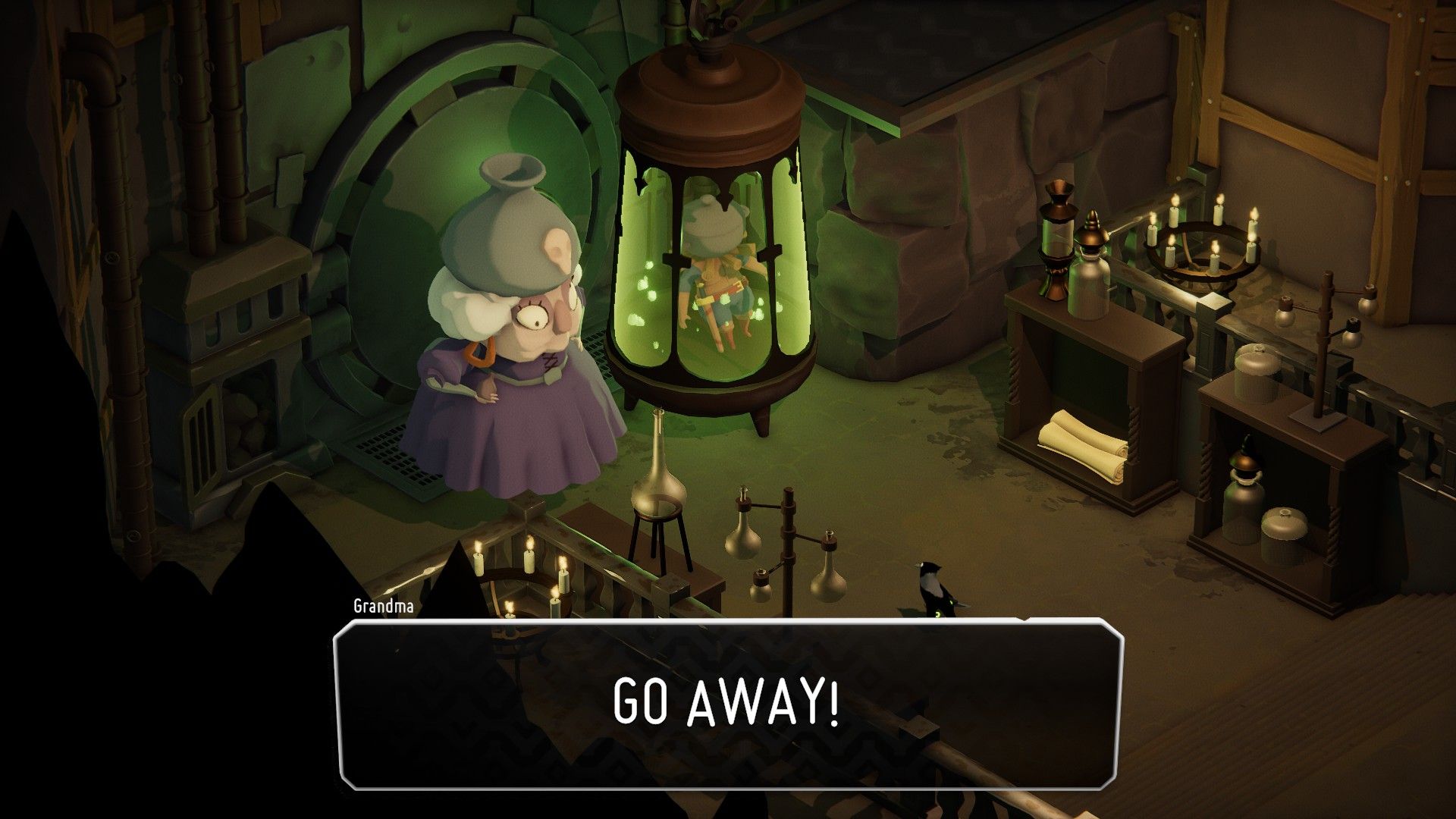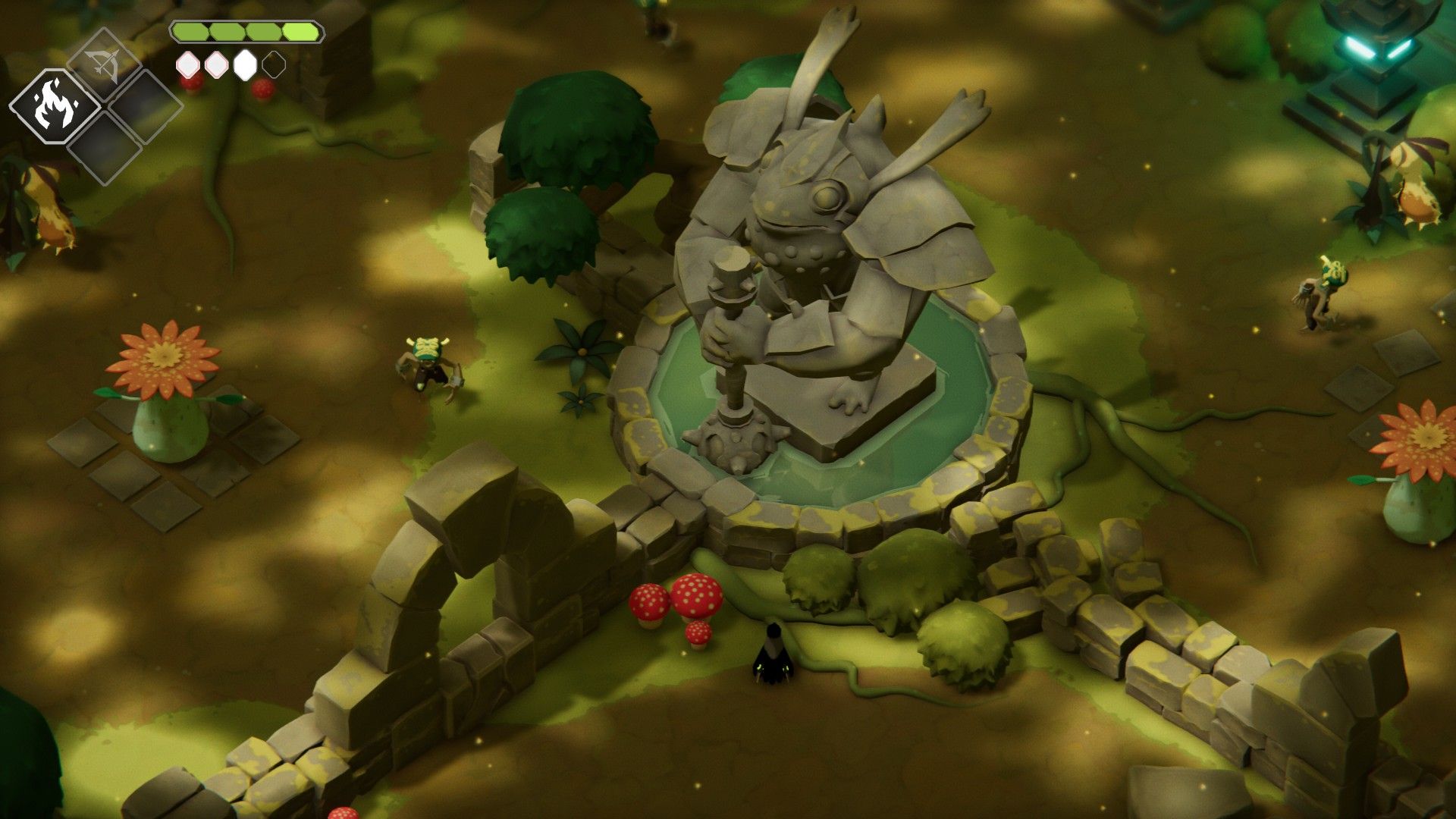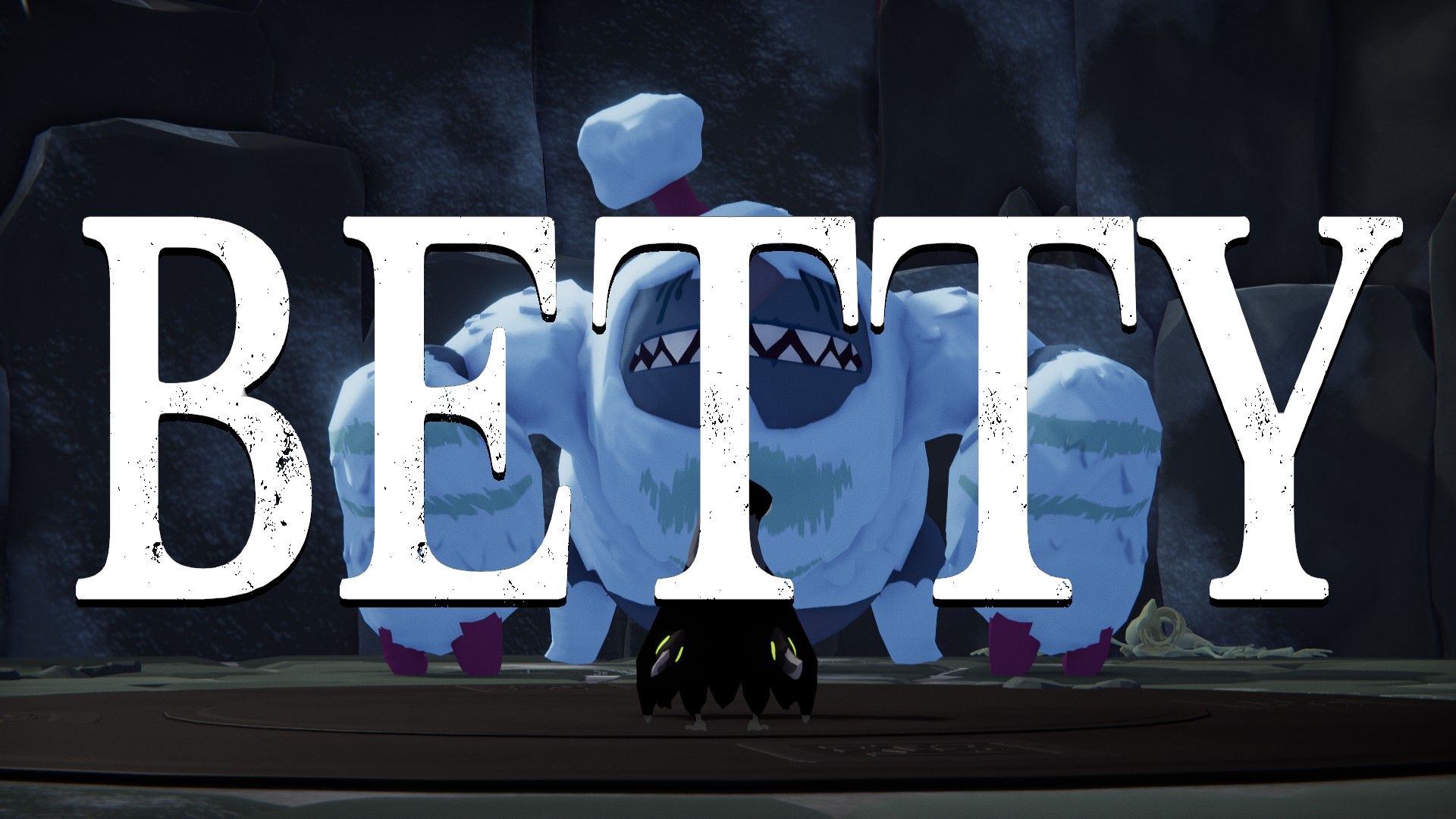Until Betty shows up. Betty is barbarous. She comes towards the tail end of this 12-15 hour story, in which a young crow is trying to bring balance to a weird corvid institution that governs life and death. Betty is an outlier. A big, hairy, Yeti-shaped outlier, who stinks. But let’s put her to one side to talk about the rest of this handsome, musically gifted adventure. Your silent crowtagonist is working as a reaper of souls, and an important soul has been stolen. Off you skitter on a journey to defeat various bosses and solve dungeon puzzles to recover the missing spirit. Combat is firmly set at an isometric angle, a mix of slashing and backing off to fire ranged attacks. You can recharge your bow by hitting enemies, or environmental objects like mushrooms or ice shards. Other ranged attacks are unlocked later, such as a fire spell or a magic bomb. You don’t lose your souls when you die, or even a lot of progress. There’s none of that to worry about. Checkpoints are plentiful, as are unlockable shortcuts. And perishing in a boss fight always lands you back at the foot of the boss arena. There are healing flower pots placed helpfully before and after tougher gauntlets. It’s all very forgiving and amicable. Anyone expecting a self-flagellating slog might be underwhelmed. But lightness suits this game much better. It’s got some smiling writing that’ll doubtlessly be funny to some, twee to others. But it got laughs from me, and that’s all I care about. Either way, Sekiro-level difficulty would clash with its carefree tone and animated style, so I’m glad it (mostly) avoids that. This is low-poly nouveau that brings to mind cute dioramas, with depth of field and smooth surfaces making details pop where you might miss them in other games. The way your shadow grows long in certain doorways, or leaves scatter briefly when you roll through them. There is so much appeal in simply tottering around. As you’d expect from a Zelda-ish wander ’em up, there’s reason to totter. There are secrets hidden all over. Disguised passages with stat-boosting shrines at the end. Gaps in hedges inviting you to rustle about in overgrown shrubs (just like a real crow). There are cracked walls that require an as-yet-unknown explosive ability to blast away, cobwebs to burn with inevitable fire-slinging, gaps that can only be crossed with an upcoming gadget. You notice lots of these potential secrets before getting the necessary powers, so there’s a big incentive to waddle through old areas and scour the game for completionist trinkets. Naturally, that’s more appealing to the backtrack brigade than those like me, who kinda just want to complete the tale. Enemies stand in the way of that. There are grunt dorks and teleporty wizards and hammer-wielding hellions. But the end-of-dungeon bosses are the main event. These battles follow time-honoured traditions of pattern and phase. Bright projectiles, smashes, stomps and swipes mix to create learnable foes. The urn witch, Grandma, is your first true biggo. She mimics the hopping attacks of her lesser minions, and throws pots with different effects at you. But by this point the preceding dungeon has done a good job of teaching you what her different pots and enemy types do, which means the boss is “readable” almost at once, making you feel capable and clever for deflecting her dangerous projectiles back into her. Other bosses have a more puzzley feel as you contend with the quirks of their arena, like collapsing floor panels. And one boss is a spike in difficulty that makes others look languid. Yes, Betty, I’m talking about you. I found this fight aggravating compared to the others because her big gorilla arms sort of “cage” you in when you try to dodge, and the view makes it hard to judge where her bulky jumps will land. She’s just a big, boring slammer. I hope she never finds love. Betty isn’t the only thing that ruffled my feathers. The key bindings for controller, for example, are a bit silly. For example, the button for going “back” on a menu (the B button on an Xbox controller) is matched to the button for charging your ranged attack in-game. That’s okay. But if, like me, you want to change the in-game B button to be “dodge” (I have a debilitating case of Souls Fingers) you’ll find that pressing that button on menus no longer works as “back”. I’m guessing there’s a fiddly code reason for this, but hopefully a future patch might separate menu controls and in-game controls. Likewise, the stat upgrading feels redundant. Your soulbucks can be spent in a hub world of stylish monochrome, a magic office with a skeleton crew of typists. But the upgrades are basic and barely noticeable. A marginally faster run speed, a negligibly speedier charge-up on ranged attacks, a decimal point more damage with sword swings. Whereas abilities have clarity of purpose and specific roles in combat and exploration, the invisible increase to your crowtagonist’s virtual innards feels insignificant. Cumulatively, it makes a difference. But it’s hard to notice. These are niggling shortcomings for a game that generally feels as good as it looks. And it looks good. For a mostly top-down game, there are loads of breakaway moments of neat composition. The framing of each boss before a big fight, for example, plasters the boss’ name up on the screen in big print. I like that. Except when it’s- The thing is, I understand what Betty is. She is the actually-hard boss. A dirtbag gatekeeper designed to inspire a backtrack through old dungeons, a soul-jaunt to find secrets, upgrades and shrines now accessible thanks to unlocked abilities. She is a reviewer’s bane. I’d rather just see the end of the story to wrap it up, thanks Betty. But reviewer’s bane is not necessarily player’s bane. And I’m sure others will inevitably find her a pushover. I also know if I’d been less pressed for a deadline, this hairy poo-flinger wouldn’t have been so bad. So apart from the fact that I AM BUSY, BETTY, I’m pleased with Death’s Door. I like the endearing head twitches of crowboy during his idle animations. I like his birdy Naruto waddle. He is a cool wee guy. I enjoy how handy the camera is, allowing you to nudge the view and peek in any given direction (an always-appreciated feature in side-on metroidvanias or top-down slice ’n’ shoots). I like how the music in the furnace dungeon is perfectly timed with the tempo of its steam pistons (the music in general is downright excellent, veering from eerie Firelink lament-o-notes to full-on forest dweller bops). I both like and am deeply unsettled by Grandma’s Studio Ghibli eyes, which follow you around the room with the automated paranoia of security cameras. In short, Betty is horrible, another another god-forsaken ape. She killed me more than all other parts of the game combined. But importantly, she didn’t kill my appreciation for the game, a sturdy and often funny fable about death. No, I don’t know when they’ll announce the Switch version. Go away.


